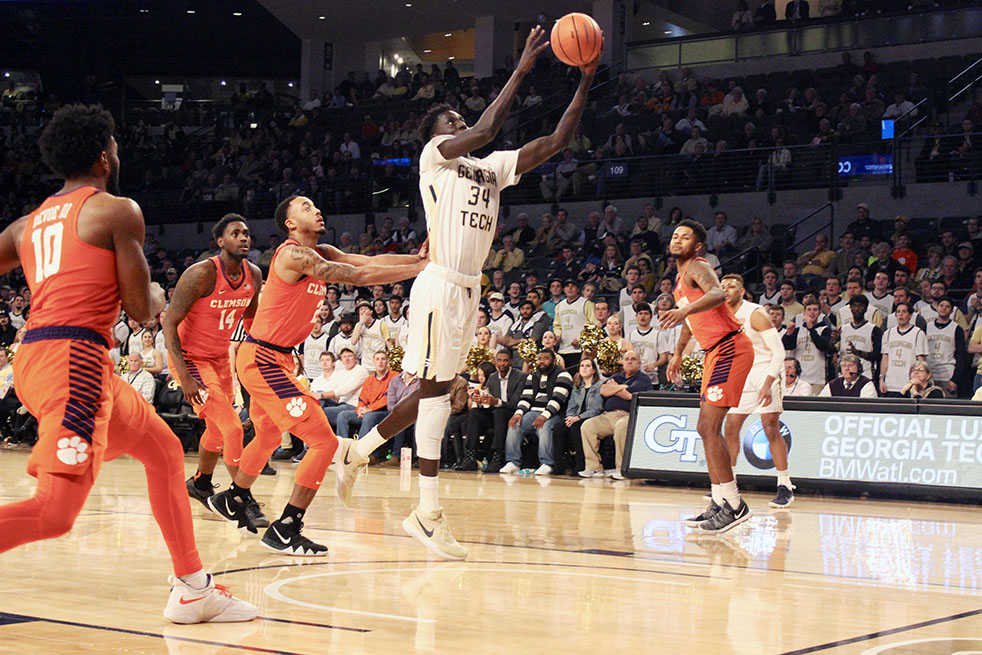Tech hoops in the “Pastnerball” era has been arguably the most popular team on campus, if for no other reason than the two-year period’s alignment with some of CPJ’s worst seasons in his tenure at Tech. Josh Pastner, named ACC Coach of the Year in his inaugural season, is a branch off the old Lute Olson coaching tree at the University of Arizona that has flourished since his arrival in 2016. Pastner’s first year surprised many as the Jackets wildly overperformed in comparison to the preseason projections that had Tech going winless in ACC play — with an upset over No. 5 UNC in his first conference game, Pastner’s squad racked up four top 25 wins over the course of the year, ending 8-10 in ACC play.
Pastner’s second season came with some seriously readjusted expectations for what a “successful” season meant. While going from a 21-16 to 13-19 overall record was far from what was anticipated going into the year, the combination of stymieing losses to clearly inferior opponents — like Grambling State, Wofford and Wright State — and the extended absences of key contributors, including then-freshman guard Jose Alvarado, senior guard Tadric Jackson and sophomore forward Josh Okogie was enough to derail a promising young team’s season from the start.
This third year sets up an opportunity for Pastner to truly begin implementing his system with the players he recruited as opposed to the ones he was handed when taking the coaching position, and when looking at the trio of freshmen infused to the team this offseason, the first thing that sticks out is just how small they are. Granted, most people wouldn’t describe the 6’8, 200-pound freshman forward Kristian Sjolund as a diminutive figure. But when comparing him in a unit along with the other true freshmen 6’6 forward Khalid Moore and 6’3 guard Michael Devoe to the graduating frontcourt presence of 6’10” graduating center Ben Lammers and the 6’5” first-round athletic phenom Okogie, there’s a clear drop in the average height of the roster, which indicates a shifting offensive philosophy in the upcoming season.
Tech finished in the bottom 15 in the NCAA for three-pointers attempted the past two seasons, an unsurprising statistic given the “grit and grind” slow-paced offense Tech had utilized with moderate success that led to lower possession counts while primarily scoring through high-percentage Lammers shots. This year, however, Lammers is gone, and with no true “big body” inside to fill his shoes and pound the boards on both sides of the floor, the guard-heavy Jackets roster will likely find themselves in small-ball lineups for the majority of their games, using junior Abdoulaye Gueye as a stretch-five starter to space the floor alongside more polished shooters.
While Tech’s new freshmen recruits may not have the physicality of their predecessors, the offensive tools each of them brings to the table unlocks a world of potential in an era of spacing. Devoe, the four-star recruit headlining the recruiting class, shot 42 percent from deep last season at the elite Montverde Academy. Devoe ran the American Athletic Union (AAU) scene impressively, leading his high school team in scoring en route to the national championship. Sjolund, an international prospect slightly undersized for the three, has an offensive toolbox that allows him to carve up defenders, and with Moore acting as a defensive anchor with a freakishly long wingspan, it is not unreasonable to believe that all three freshmen will see significant playing time together.
A potential lineup is Devoe and Sjolund or Moore starting alongside floor general Alvarado, rim protector Gueye and a fully healed 3-point assassin sophomore Curtis Haywood. While that unit would give up plenty in size, the hope is that it would be able to compensate for its diminutive nature with athleticism and scoring, the latter of which has been something of a challenge for Tech basketball.
With a lineup of Alvarado, Devoe, Haywood, Sjolund or Moore and Gueye, Tech would be doing a full pivot from the defensive intensity that has been the backbone the program’s success for the past decade. Alvarado’s high motor leads to a healthy amount of steals and Gueye has been a serviceable interior presence in years past, but to expect the freshmen to come in and be immediately prepared to defend at the next level with an increased net athleticism level and pace would be foolish. The effort may be there, but it is unlikely that their inexperience will do them any favors on the defensive end, particularly against freak athletes and grizzled veterans in conference play.
That being said, the pieces are in place for Pastner to finally begin molding the Jackets in the image of his old Memphis teams that ran a high-scoring offense that carried the team to 4 NCAA tournament berths in his 7 years as head coach. Change will not happen overnight, but it begins here.
